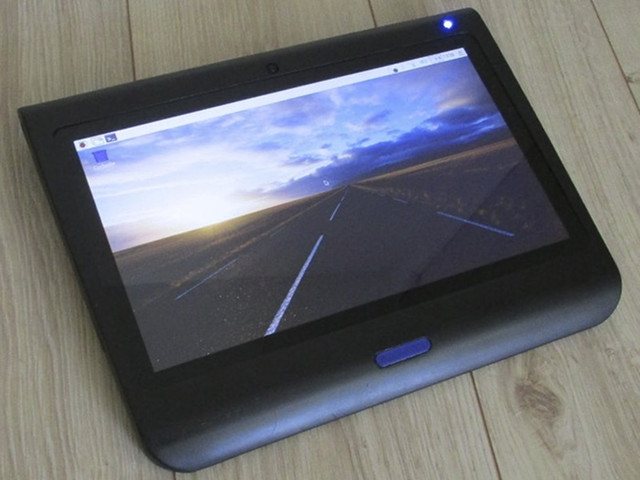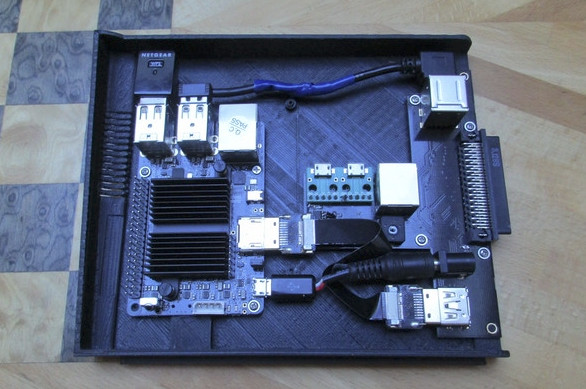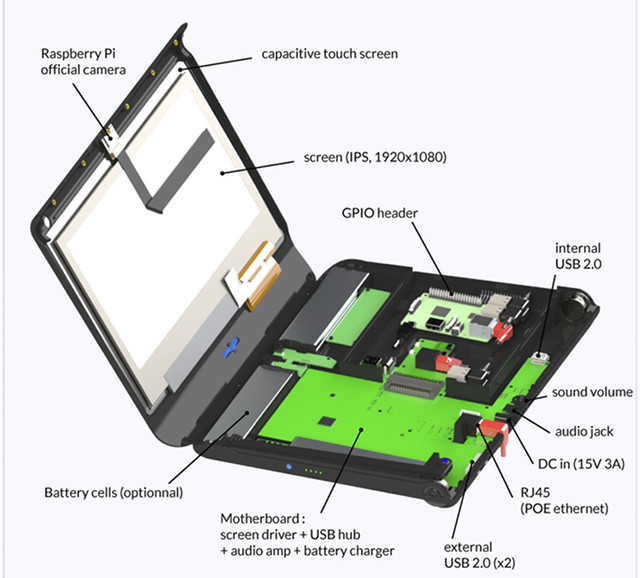If your project requires a touch panel, there are plenty of solutions for Raspberry Pi and ODROID boards, with Hardkernel even selling ODROID-VU8C fully integrated touch panel display. However, most display kits require you to make your own case, and feature smaller displays with lower resolution. One developer has however come up with Diskio Pi, a higher-end touch panel kit with a 13.3″ Full HD display that works with the most popular Raspberry Pi and ODROID boards.

Diskio Pi specifications:
- Display – 13.3″ AUO TFT IPS display with 1920×1080 resolution connected via a 30-pin eDP connector ; 330 cd/m2 brightness; 85° viewing angles in all directions.
- Touch panel – 10-point capacitive touch; G/G structure; USB 2.0 interface; ≥6H surface hardness.
- Main board:
- HDMI to eDP driver
- Stereo sound amplifier
- USB 2.0 hub with 3x ports: 2x external + 1x internal
- Battery balance circuit (3S/3S2P)
- Expansion – Various headers for prototyping (RJ45, USB…)
- Misc – Left & right mouse buttons (home button, USB); circuit protection via fuses, diodes…
- Power Supply – RJ45 POE+ (Power over Ethernet)
- Rack board:
- Connections with the board via cables: 4 x USB, 2 x Ethernet, 1 x Power, 1 x HDMI
- Fan circuit with potentiometer (fan will be optional)
- Speakers – 2x round 3W speakers
- Power Supply – 5V 3A from main board
- Power Supply – 15 or 18V AC/DC adapter with EU, UK or US plug
- Battery – Optional 6 cells LiPo 3.7V=11.1V, 8000mAh
- Dimensions – 348 x 265 x 25 mm (Final dimensions may change slightly)
- Weight – 1.8 kg (prototype)

Diskio Pi is currently compatible with Raspberry Pi 2, Raspberry Pi 3, Raspberry Pi Zero (W), ODROID C1+, and ODROID C2, but later, a modified kit will offer support for ODROID XU4 and Intel Atom based UP board. You can run any operating system you’d like since HDMI is used for video output (and converted to eDP), and USB used for the touch panel. You’ll be able to use accessories like the official Raspberry Pi camera, and there’s even space to add extra boards or modules like an Arduino mini or sensors using the IO headers or the internal USB port. The kit could be use as a large (and thick) tablet, an home automation dashboard, a portable Linux computer, etc…
The project has just been launched on Kickstarter with the aim of raising at least 400,000 Euros, which may prove to be a challenge, but we’ll see. The “very early adopter pack” rewards requires a 350 Euros pledge for Diskio Pi with the power adapter, but no battery, nor a Raspberry Pi or ODROID board. The 45 Euros battery pack is optional is reserved “for users who don’t need the POE+ power”. Shipping adds 9 Euros to France, 16 Euros to most of Europe, and 36 Euros to the rest of the world, with delivery scheduled for February 2018. The person behind the project has 10-year experience as… an optician, but he’s been working on the prototype for 18 months, and Advansee will take care of the final embedded electronics design, while CD-Plast will handle the mechanical design, with both companies based in the west of France.

Jean-Luc started CNX Software in 2010 as a part-time endeavor, before quitting his job as a software engineering manager, and starting to write daily news, and reviews full time later in 2011.
Support CNX Software! Donate via cryptocurrencies, become a Patron on Patreon, or purchase goods on Amazon or Aliexpress





Funny that this project only focusses on two large SBC vendor communities while it’s also fully compatible to MIQI and Tinkerboard (Rockchip RK3288), NanoPi K2 (Amlogic S905) and soon the sad BPi-M2 Berry (Allwinner V40) and ROCK64 (Rockchip RK3328 — needs a different power cable though since not using crappy Micro USB).
Also interesting how the focus on the wrong type of device (relying on TV box SoCs and not tablet SoC+PMIC) can increase costs dramatically. If I would want something with a touchscreen running Linux and able to be carried around (battery support) most probably I would get a cheap A64 tablet or an older RK3288 Chromebook and use my Linux distro of choice.
Hi tkaiser,
I was looking into putting Linux on a RK3288 Chromebook, crouton or native, but had no luck finding it possible.
Can you help?
BTW: Diskio Pi for 350€ is way too much, in my opinion.
I created a similar comment minutes ago, it may be duplicated, sorry if that happens.
@tkaiser
The cost is rather high, but it’s also quite more flexible than a simple tablet, as there’s space for extra boards/modules via USB and IO headers, and 3D files will also be provided, so you can do potential repair or modifications yourself.
Running Linux on this hardware will also be easier, than on some random tablets. Nevertheless, he needs around 1,000 backers willing to spend ~400 Euros on the solution (over twice as much as a 13.3″ full HD tablet), so we’ll have to see if funding is successful.
@cnxsoft
All true, I was just stunned seeing the ‘How will your money be spent?’ graph on Kickstarter mentioning ‘Electronics components’ being the largest part (25.2%) while ‘Touch Screen’ (14%) and ‘Screen’ (7.3%) aren’t part of this. And batteries are optional and add additionally to the costs. Made me thinking about a different approach choosing appropriate hardware in the first place (eg. tablet SoC + PMIC with full battery support and maybe even already native eDP), then adding missing components and focus on software instead. Obviously the above approach is quite the opposite and I’m not part of the target audience 🙂
@AlexN
Unfortunately I can’t help, haven’t even looked into any boot details with Rockchip yet (but there’s a RK wiki explaining stuff). I just played around with Pinebook the last months to get Armbian behaving nicely on a laptop and sporadically providing little help with Tinkerboard porting since in the end I want Armbian on a Chromebook myself. 😉
Wrt Diskio Pi pricing I mostly agree but please keep in mind that similar ‘mobile hacking platforms’ like Novena Laptop for example cost way more (though the Novena is truly open source in every aspect, the idea alone to combine something like a Rasperry Pi having to run a proprietary main OS on the VideoCore — the so called ‘firmware’ — with the word ‘open’ let me shudder 🙂 )
@AlexN
As tkaiser says. https://wiki.debian.org/InstallingDebianOn/Asus/C201
I’d say that the concept is appealing and goes into the direction that made the success of the PC (ie: assemble compatible pieces without regretting having done the wrong choice on one component 6 months later). It can be nice for some home appliances. But that’s very expensive. The Odroid one is one third of the price and is a complete enclosure as well. FriendlyARM used to propose a display kit on which it was possible to attach the board, for something around $60. They just have to close it and it serves the same purposes.
I agree with @tkaiser that they might have targetted too many features and the resulting design is expensive and complex. But that’s the price of universal compatibility. The risk for them is that some more trained companies start and complete a competing design before they even finish their kickstarter campaign.
I tend to like its description but am not willing to pay that much for this. $100-$150 would probably be OK.